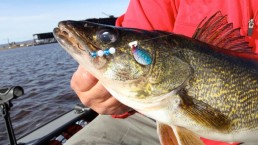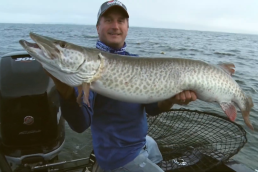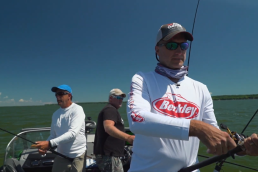Longline Trolling Spinners Over Shallow Flats
SHARE THIS POST
(Companion web site feature for Spring Walleye Strategies Part 2—Post-spawn, from May 2022 magazine issue)
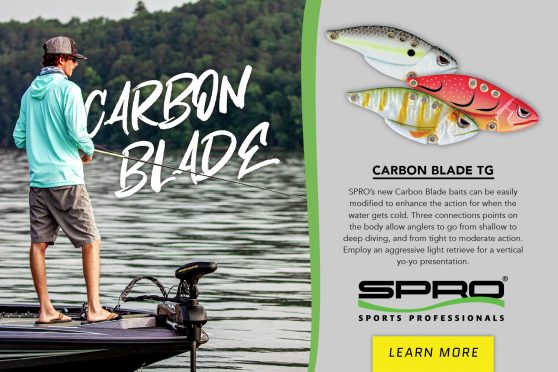 Posts-pawn walleyes disperse from their spawning sites to the nearest forms of available cover with forage. Rather than aimlessly roaming flats in search of baitfish, they tend to gravitate into areas with some form of cover like rocks and weeds, even if the weeds are just beginning to develop. In fact, when weeds don’t yet reach the surface, it is easier to fish large areas by trolling lures or baits in the open water between the surface and the weed tops.
Posts-pawn walleyes disperse from their spawning sites to the nearest forms of available cover with forage. Rather than aimlessly roaming flats in search of baitfish, they tend to gravitate into areas with some form of cover like rocks and weeds, even if the weeds are just beginning to develop. In fact, when weeds don’t yet reach the surface, it is easier to fish large areas by trolling lures or baits in the open water between the surface and the weed tops.
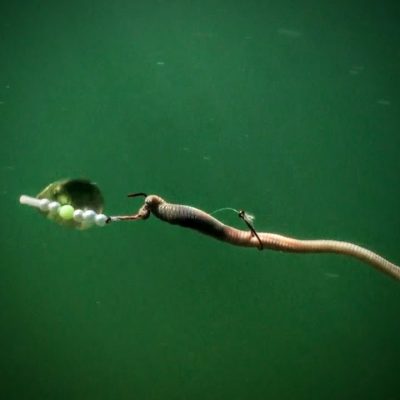
Anglers often troll minnow-shaped crankbaits in this zone, with is undoubtably a fine adaptation to the circumstances. Another good option is lightly weighted spinner rigs dressed with live nightcrawlers or soft plastic crawler, leech or minnow imitations. In recent years, walleye anglers have moved to increased use of softbaits because they deflect the pulls and tears of panfish that can quickly rob your rig of live bait. This ensures that your spinner rig is always fully loaded for fish action.
You don’t need overly large spinners in the shallows. Size 1 to 3 Colorado or Indiana blades work fine, with sufficient water resistance to keep your rig up above bottom. Too large a blade, and you run the risk of your spinner rising and popping out of the surface. Place a small barrel swivel inline ahead of the spinner to prevent line twist.
Consider placing a split shot or two about 2 to 3 feet ahead of your spinner to help keep it subsurface at slow trolling speeds of 1 to 1.5 mph—just enough to get the blade rotating, flashing and pulsing with vibration to both attract fish, and impart a lifelike action to your plastic bait.

Are you enjoying this post?
You can be among the first to get the latest info on where to go, what to use and how to use it!
Troll your rigs about 75 feet behind the boat, preferably using an electric motor for stealth. You can handhold a rod, imparting an occasional surge-pause to the rig by pumping the rod forward, then dropping the rod tip back, to help trigger strikes. Or simply place rods in rod holders and troll in S-shaped paths to make spinners on alternate sides of the boat speed up, then slow down or perhaps even flutter a short distance. If fish tend to hit on either the slower or faster side, it provides a clue to either slow or speed up your trolling speed to match their preference for the day.
Where legal, consider trolling 4 lines to even 6 lines, using planer boards to position lines and rigs to either side of the boat. This broadens your search across a wide swatch and increased your chances of locating fish and cover and establishing productive depths.
Planers boards also allow you to run lines right up to shorelines or the ends of docks without spooking fish with the boat’s passage. Add a glow stick to your planer boards, and you can even troll effectively at night.
Dave Csanda has enjoyed 40 years in the fishing communications industry at In-Fisherman, Angling Edge and now, as editor of MidWest Outdoors. He is an inductee of both the Minnesota and National Fresh Water Fishing Halls of Fame.
Become a MidWest Outdoors Insider here!
MWO
SHARE THIS POST
Did you enjoy this post?
You can be among the first to get the latest info on where to go, what to use and how to use it!
Dave Csanda
Dave Csanda has enjoyed 40 years in the fishing communications industry at In-Fisherman, Angling Edge and now, as editor of MidWest Outdoors. He is an inductee of both the Minnesota and National Fresh Water Fishing Halls of Fame.
